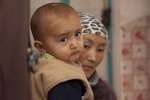- Text size
 |
|  |
|  |
| 
- Français
Q&A: Campaign against statelessness gains ground
News Stories, 12 September 2013
GENEVA, September 12 (UNHCR) – There are at least 10 million stateless people worldwide, but there is a growing global concern about their situation and an increasing commitment to alleviate their plight. Since UNHCR launched a campaign in 2010 to spread awareness about stateless people and to boost support for the two UN conventions on statelessness, many countries have taken steps to improve the situation by acceding to one or both conventions. In July, Lithuania became one of the newest parties to the 1961 Convention on the Reduction of Statelessness – serving as an example for other EU member states and former Soviet republics. This came just as Lithuania took up the six-month presidency of the EU, adding to its impact. The development was welcomed by UNHCR, which has the UN mandate to prevent and reduce statelessness around the world, as well as to protect the rights of stateless people. Lithuania's efforts to tackle statelessness since the end of Soviet rule in 1991 are impressive – there are only about 4,000 stateless people there compared to almost 400,000 in the two other former Soviet Baltic republics, Estonia and Latvia. Mark Manly, head of UNHCR's Statelessness Unit, recently discussed the issue of statelessness with Daniel MacIsaac of the agency's Communications and Public Information Service. Excerpts from the interview:
Tell us about the current global trends in statelessness
The magnitude of the problem has fluctuated in recent decades. The massive numbers at the beginning of the 1990s were gradually reduced as new states in the former Soviet Union granted citizenship to hundreds of thousands of people. The numbers increased again with developments in other parts of the world, such as in the Caribbean and southern Africa. A perennial source of new cases of statelessness is gaps in nationality laws which leave children stateless at birth – usually because their parents are stateless. We are also concerned by new cases of state succession such as the recent independence of South Sudan. If the rules for nationality are not well thought through and implemented, thousands of people can fall through the cracks, just as occurred in the former Soviet Union. Such situations can take years to resolve. There are still well over half-a-million stateless people in the former Soviet Union.
What does statelessness mean for people in their daily lives?
This is the key issue because if there was wider understanding of the terrible impact on people's lives, it would be far easier to mobilize governments to take action. Conditions vary widely but, typically, stateless people live in the country of their birth but have no lawful residence and no documentation to prove identity. This has severe knock-on effects because lack of legal status generally means children cannot be registered at birth or go to school; people are generally unable to work legally, own land, enter into contracts, inherit property, open bank accounts . . . I have met people who were scared to leave their homes because of the likelihood of being detained by the police, simply because they cannot prove their identity. People often report they have difficulties getting married and some who do marry decide not to have children because they would also be stateless. We have met many bright people who manage to get some formal education but cannot progress professionally without nationality. They end up accepting low-paying jobs. And there is major psychological impact in many cases – including depression with strong feelings of helplessness, frustration and exclusion.
What has UNHCR done to reduce statelessness and what are the biggest challenges?
The first step is to map out who is stateless and how they became stateless and to look at obstacles to acquisition of nationality. We are doing precisely this work now in many countries around the world, including in a number of former Soviet states. Once we have better understood the problem, we can discuss with the government why action is needed. This is sometimes a major challenge because the issue of nationality goes to the very heart of a state's identity. Who belongs and who does not? Often historic divisions within the population are involved and, more often than not, the stateless people belong to minorities, like the Rohingya in Myanmar. Once there is some acknowledgement of the problem, we can begin discussing necessary changes in the nationality law and procedures, and any other action required.
Often a few small changes in the law and introduction of simplified procedures for the acquisition of nationality can enable a large number of stateless people to acquire nationality in a short period, generally for very little cost. It is also important to avoid new cases and a key step is to ensure that every child born stateless acquires the nationality of the country in which he or she is born. This breaks the cycle of transmission of statelessness from one generation to the next and is one of the basic safeguards against statelessness contained in the 1961 Convention.
Why are some countries reluctant to sign up to the two Conventions?
Often it is not a question of reluctance, but of lack of knowledge about the Conventions and their importance. Until 1995, no international agency was promoting the two Conventions – UNHCR has been doing so since then under its statelessness mandate from the UN General Assembly. We have found that most governments are receptive when the advantages of the Conventions are explained. In particular, that it is in the interest of everyone – states and stateless people – that there is a minimum set of rules applicable to all countries. A lot of governments agree, which is why 33 states pledged to accede to one or both Conventions in 2011 and also why we will likely achieve near-universal ratification of these Conventions in the Americas and Europe in the near future, as well as a very high level in Africa. Of course, there are states in various parts of the world which are unlikely to accede in the near future. For example, the 1961 Convention requires that states have safeguards in their nationality laws to prevent statelessness from occurring, but some countries have very problematic nationality laws and are not inclined to change them in order to accede to the 1961 Convention.
What exactly is happening now, and what do you want to see happen?
We are seeing progress. The 50th anniversary of the 1961 Convention in 2011 was a turning point. Working with a small number of champion countries and NGOs, we were able to explain to many governments why they need to be concerned by the impact of statelessness on individuals, and on society more broadly. Since then, we have heard an increasing number of governments say that statelessness is not acceptable and take action to address it. In fact, more than 60 governments pledged to take action on the issue in 2011 and a quarter have followed through by reforming their nationality laws and adopting procedures to identify stateless people. We have had an unprecedented number of accessions to the stateless conventions – 29 since the beginning of our campaign in 2010. To put this in perspective, the 1961 Convention attracted only 15 accessions in the three decades after it was adopted. Just in the past two months, Lithuania acceded to the 1961 Convention and Nicaragua to both Conventions. We were very encouraged that the national assembly of Côte d'Ivoire recently approved accession to the two Conventions. This is an important step towards resolution of the major statelessness problems in Côte d'Ivoire. We are encouraging other states to show leadership on this issue by acceding to the Conventions.
Will statelessness in the world ever be eradicated?
We are very happy with the progress seen in recent years but, clearly, it is not sufficient. The global stateless population remains high – we estimate over 10 million. Yet, in recent years, only a small percentage has acquired nationality each year – about 1 per cent. To make a major difference we need to see breakthroughs in the countries with large stateless populations. Next year is the 60th anniversary of the 1954 Convention relating to the Status of Stateless Persons, and one of our major messages will be that statelessness can be eradicated. To achieve this, though, more policy makers need to understand that this is one of the overlooked human rights crises of our time and take action.












































